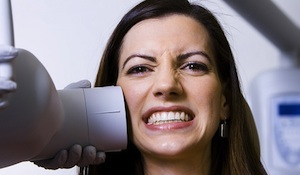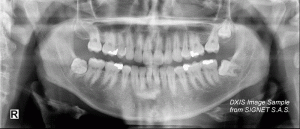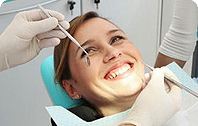X-Ray Radiation Dose – The Truth!

The average dose of radiation per person from all sources is about 620 mrems per year. However, it is not uncommon for someone to receive more or less than this average in a given year (largely due to medical procedures one may undergo). For those who work with and around radioactive material, International Standards allow exposure to as much as 5,000 mrems per year.
Common Sources of Radiation EVERYONE receives:
- Cosmic (from outer space) Radiation in Michigan = 28 mrem/year (more if you live in an area with higher elevation)
- Terrestrial (from the ground) Radiation in Michigan = 30 mrem/year
- From Food and Water = 40 mrem/year
- From Air = 228 mrem/year
TOTAL: Everyone receives at the very least 326 mrem of radiation every year.


Dental X-rays (Radiographs)
- 4 Bitewings (need once every year*) = 2 mrem
- 1 Panorex (need once every 5 years) = 4 mrem
Other Common Sources of Radiation for Comparison
- Flying in a jet airplane = 0.5 mrem for EVERY half hour of flight
- Viewing a TV or computer screen** = 1 mrem/year
- Living in a stone, adobe, brick, or concrete building = 7 mrem/year
- Smoking a half pack of cigarettes every day = 18 mrem/year
- Mammogram = 42 mrem
- Hip x-ray = 70 mrem
- CT scan of chest = 700 mrem
- CT scan of heart = 2000 mrem
Conclusion: Getting dental x-rays will be less than or equal to 0.6% of your total radiation exposure in 1 year.
At Caring Smiles Family Dentistry, we use digital radiography. Some benefits of digital radiography include:
- The film is immediately processed and available to view, whereas film takes time to be developed.
- Less radiation needed to produce the same quality image as film (digital X-rays gives 70% less exposure to radiation than conventional X-rays).
- You can enhance the digital image (such as alter brightness and contrast) with a series of processing techniques
- Digital radiography produces larger photos to make it easier to see cavities and other pathology
- Better patient education as we are able to show you your x-rays on our high definition monitors.
More importantly, the benefits of taking x-rays far outweigh the risks. Dental x-rays diagnose a wide range of problems, including but not limited to: dental caries (decay/cavities) that cannot be seen clinically (by looking in the mouth), periodontal disease (bone loss), open contacts between teeth (which can lead to food impaction and eventually gum disease), excess cement left behind after cementing a crown (which can lead to gum disease), abscesses /cysts, infections in the bone, impacted teeth, fractured teeth, cancer, genetic disorders, and much more.
Finding a dental problem early can save your tooth, time, money, and/or overall health.
So the next time you go to your dentist and she/he says it’s time for x-rays, smile and say “Great! Thanks for caring about my health!”

**TV or computer screen that uses CRT technology
If you have any questions about this or any other dental issues, or would like to make an appointment for a dental exam, cleaning, or consultation, please give us a call at 248.973.8788. We are here for you! At Caring Smiles Family Dentistry, we love sharing great dental health tips, contests, and special announcements on our Facebook and Instagram pages. Please join us on our journey of changing lives one smile at a time.
References
American Nuclear Society: http://www.new.ans.org/pi/resources/dosechart/
Martin S. Spiller, D.M.D: http://www.doctorspiller.com/Dental%20_X-Rays.htm
Photo #1 credit: http://worldental.org/images/dangers-dental-x-rays-radiation.jpg
Photo #2 credit: http://www.ddicenters.com/images/popups/bitewings.jpg
Photo #3 credit: http://www.dxis.com/_NS/_COMMON/IMAGES/Samples/Xray_Dental_Panoramic_3.gif
Photo #4 credit: http://costa-rican-medical-tourism.com/medical-tourism-pictures/smiling-dental-patient.jpg

No comments